Work Order List
If the number of the Work Order is not known, or a full search of the system to find a set of Work Orders is required, then the Work Order List function should be used.
1. The first tab of the Work Order Query Definition screen is the General tab. The User can search based on one set of criteria, or a combination of many different sets of criteria. The more refined the criteria selected the more specific the list of results returned. To search by specific areas, tick the tick box of the required areas. Each area is described below:

Created By this field displays a list users within the system in the Select Created By User(s) pop-up. Select the user to search for the Work Orders they created and click "OK".
Building this field will display the Select Building(s) pop-up. Select the Buildings criteria required and click "OK".
Resource this field will display the Select Resource(s) pop-up. Select the type of Resource, enter the name of the Resource and click "Search". Then select one of the results returned and then "OK".
Resource State this field allows for the searching for Resources that have been made Inactive. Then select one of the two states in the drop down and then "OK".
Internal Owner this field allows for the selection of an internal owner (an available field against a Resource record to mark a Resource as the responsibility of an internal user Leaving this unticked and unselected will default to All.
Internal/External this field allows for the selection of whether the returned results should cover Internal Resource, External Resource or both. Leaving this unticked and unselected will default to Both.
Type of Work Order displays the tick the types of Work Order to be searched for. Tick the required Type of Work Order(s) from the list and click "OK".
Equip/Service Types this field will display all relevant Work Order, Sub Work Order, Equipment and Services types in the Task Types pop-up. This will also show Equipment Types that are no longer available to raise Work Orders for (i.e. they are currently unticked in Core Data), but where Work Orders do exist in the system. Choose the relevant criteria and click the "OK" button.
Contract Number this enables a field which allows Users to search for Work Orders. Enter the Contract Number in the text field.
Status Groups tick the Status Group box to display the Status Groups pop-up. Select the desired Status Groups and click the "OK" button.
Note: Any fields left blank will return all by default. For example, not specifying a Building will return all Buildings - this means the User does not have to go through each field selecting all items in turn.
2. The second tab of the Work Order Query Definition screen is the Dates tab. This tab allows the User to search by specific Dates and each date field provides the user with different ranges to search by:
· Between: provides the ability to search between the two dates specified
· Exact: can search for Work Orders on the date specified
· After: can search for Work Orders after the date specified
· Before: can search for Work Orders before the date specified
· Today: searches for Work Orders using today’s date
· Yesterday: searches for Work Orders using yesterdays date
· Last 7 days: searches for Work Orders over the last 7 days
· Between: provides the ability to search between the two dates specified
· Exact: can search for Work Orders on the date specified
· After: can search for Work Orders after the date specified
· Before: can search for Work Orders before the date specified
· Today: searches for Work Orders using today’s date
· Yesterday: searches for Work Orders using yesterdays date
· Last 7 days: searches for Work Orders over the last 7 days
Below is a description of each of the different date fields that the user can search by:
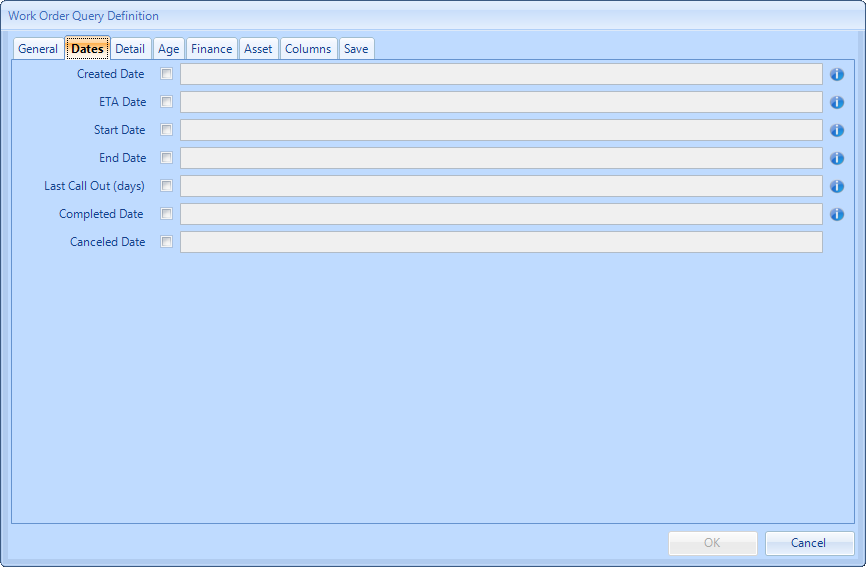
Created Date provides the ability to search by the date the Work Order was created. The Creation Date of the Work Order.
ETA Date allows the User to search by the date the ETA set on a Work Order. The estimated time of arrival on the work order.Start Date provides the ability to search by the date the Scheduled Start Date/Attendance Date (Reactive and Quote) or Visit Start Date (PPM).
End Date allows Users to search by the the End Date of a Between schedule (Reactive and Quote) or Visit End Date (PPM).
Last Call Out (Days) allows Users to enter a number of days and to search by the number of days since a Call Out action has been completed on the work order.
Completed Date allows the User to search by the date the Work Order was completed.
Canceled Date allows the User to search by the date the Work Order was cancelled.
3. The third tab of the Work Order Query Definition screen is the Age tab. This tab is where Users can search for Work Orders based on how far away/overdue they are from their SLA or ETA. When using these fields, the User has the ability to choose by how many Hours, Days, Weeks or Months the Work Order is either Overdue or Expires Within. Here are the different fields in the Age tab:
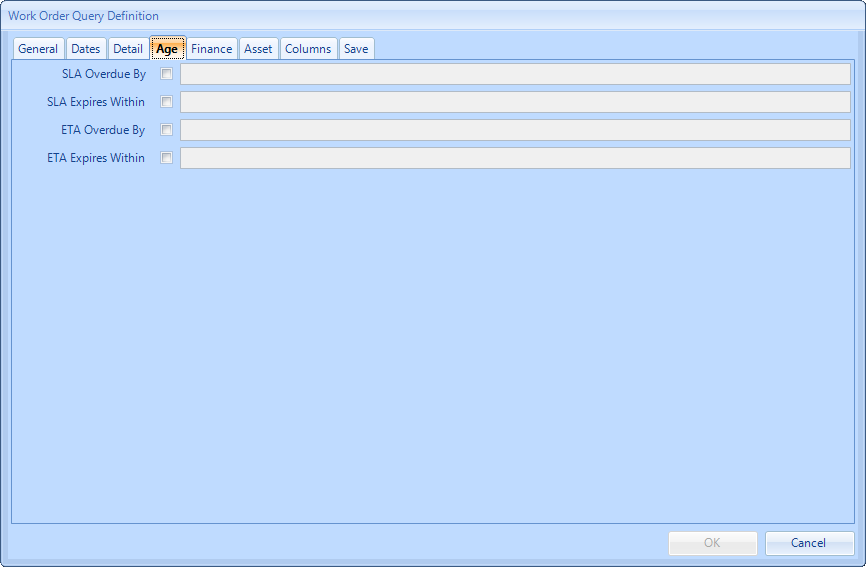
SLA Expires Within provides the User the ability to search by how long the till the Work Order passes the SLA Date.
ETA Overdue By provides the ability to search by how long the Work Order is overdue by the ETA Date.
ETA Expires Within provides the User the ability to search by how long the till the Work Order passes the ETA Date.
4. The fourth tab of the Work Order Query Definition screen is the Detail tab. This tab is where Users can search for Work Orders of specific status or of specific types such as Work Orders in Authorisation. Here are the different fields in the Detail tab:
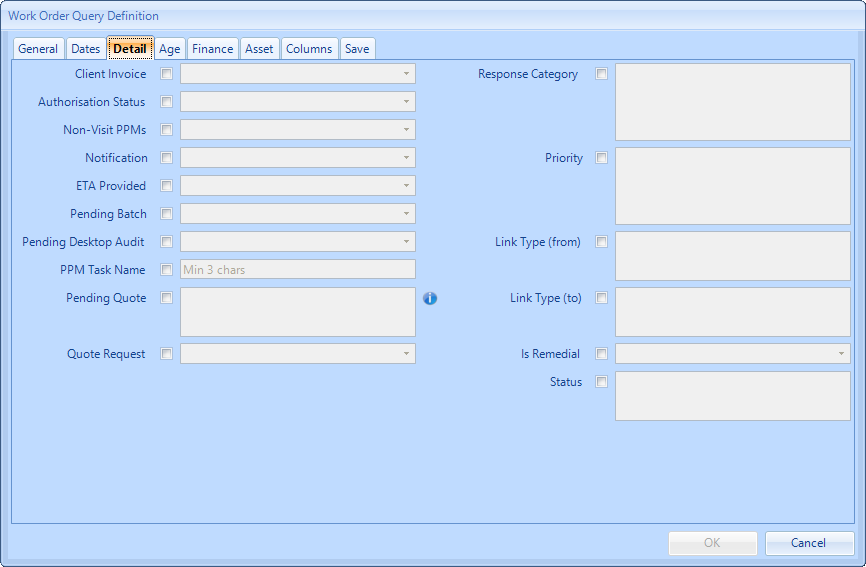
Associated to Client Invoice? This is a drop down with the following options:
· Eligible for invoicing: selecting this brings back all Work Orders that are eligible to be added to a Client Invoice for the selected Client(s)· Invoice pending: selecting this brings back all Work Orders that are currently on Client Invoices that are pending submission
· Invoice submitted: selecting this brings back all Work Orders that are currently on Client Invoices that have been submitted
Authorisation Status This drop down gives users the choice to search for Work Orders that are in Authorisation. The options in this field are as follows:
· Pending Authorisation: selecting this brings back all Work Orders that are currently awaiting authorisation for the selected Client(s)
· Not Pending Authorisation: selecting this brings back all Work Orders that are not awaiting authorisation for the selected Client(s)
· Last authorised action - Authorised: selecting this brings back all Work Orders where the last authorisation action to occur was the Work Order being authorised, for the selected Client(s)
· Last authorised action - Refused: selecting this brings back all Work Orders where the last authorisation action to occur was the Work Order being refused, for the selected Client(s)
· Pending Authorisation - On Hold: selecting this brings back all Work Orders that are currently on hold for the selected Client(s)
· Pending Authorisation - Information Required: selecting this brings back all Work Orders that are currently awaiting further information for the selected Client(s)
· Any authorised actions - Authorised: selecting this brings back all Work Orders that have been authorised at any point, for the selected Client(s)
· Any authorised actions - Refused: selecting this brings back all Work Orders that have been refused at any point, for the selected Client(s)
Non-Visit PPMs? This is a "Yes/No" drop down. Selecting "Yes" means the search will look for Work Orders that have been raised as closed and do not have any visits on them whilst selecting "No" will exclude Work Orders that were raised as closed.
Notifications? This is a drop down list with the following options:
· Yes - Active only: selecting this brings back all Work Orders that have active notifications on them
· Yes - Inactive only: selecting this brings back all Work Orders that have inactive notifications on them
· Yes - All: selecting this brings back all Work Orders that have notifications on them whether they are active or inactive
· No: Selecting this when searching displays Work Orders that don’t have any kind of Notification on them
ETA Provided? This is a "Yes/No" drop down. Selecting "Yes" means the search will look for Work Orders where the ETA Provided action has been performed whilst selecting "No" will look for Work Orders where ETA Provided action has not been performed.
Pending Batch? This is a "Yes/No" drop down. Selecting "Yes" means the search will look for Work Orders that are pending Batch whilst selecting "No" will look for Work Orders that are not pending Batch.
Pending Desktop Audit This allows for the return of any Work Orders that are awaiting a Desktop Audit for the specified user in the drop down.
Notifications? This is a drop down list with the following options:
· Yes - Active only: selecting this brings back all Work Orders that have active notifications on them
· Yes - Inactive only: selecting this brings back all Work Orders that have inactive notifications on them
· Yes - All: selecting this brings back all Work Orders that have notifications on them whether they are active or inactive
· No: Selecting this when searching displays Work Orders that don’t have any kind of Notification on them
ETA Provided? This is a "Yes/No" drop down. Selecting "Yes" means the search will look for Work Orders where the ETA Provided action has been performed whilst selecting "No" will look for Work Orders where ETA Provided action has not been performed.
Pending Batch? This is a "Yes/No" drop down. Selecting "Yes" means the search will look for Work Orders that are pending Batch whilst selecting "No" will look for Work Orders that are not pending Batch.
Pending Desktop Audit This allows for the return of any Work Orders that are awaiting a Desktop Audit for the specified user in the drop down.
PPM Task Name Entering part of a PPM Short Name will return any PPMs with that text present in their name.
Pending Quote This allows for the return of any Work Orders that are pending quote receipt from Resources.
Quote Request This allows for the return of any Work Orders that are pending quote request.
Response Category This displays the Select Response Categories pop-up. Select the desired Response Categories to search by and click the "OK" button.
Priority This displays a Priority selection pop-up. Select the desired Priorities to search by and click the "OK" button.
Link Type (From) This allows for the selection of "Externalise" (Work Orders passed from Internal Resource to External Resource), "Remedial Works" (Work Orders created as a result of a PPM visit), "Standard" (Work Orders linked using the Action of Link Work Order, and "Visit" (Work Orders linked based on the joining of Work Orders to coincide with a PPM visit). The "From" will return any Work Order where the link was established from.
Link Type (To) This allows for the selection of "Externalise", "Remedial Works", "Standard" and "Visit". The "To" will return any Work Order where the link was made to.
Is Remedial This allows for the return of any Remedial Work Orders as a result of this query.
Status This displays the Select Status pop-up. Select the desired statuses to search by and click the "OK" button.
5. The fifth tab of the Work Order Query Definition screen is the Finance tab. This tab is where Users can search for Work Orders based on Finance details such as Accrual and AOV values and each field provides the user with different ranges to search by:
· Between: provides the ability to search for Work Orders who have value between the two values specified
· Exact: can search for Work Orders on the value specified
· More than: can search for Work Orders with a value greater than the value specified
· Less than: can search for Work Orders with a value less than the value specified
Here are the different fields in the Finance tab:
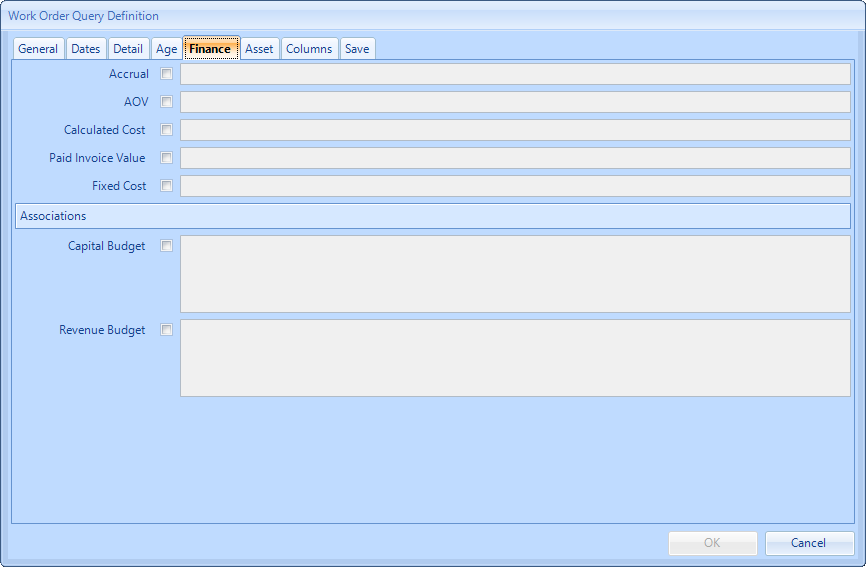
AOV provides the User the ability to search by the AOV Value on the Work Order.
Calculated Cost provides the ability to search by the Total Calculated Cost Value on the Work Order.
Paid Invoice Value provides the User with the ability to search by the Paid Invoice Value on the Work Order. This will only bring back Work Orders that have Paid Invoices on them.
Fixed Cost provides the User the ability to search by the Fixed Cost value on the Work Order. This will only bring back Work Orders that have Fixed Costs on them.
Below this is the Associations section. In here, it is possible to search for Work Orders based on what budget code is against them. There are two search options here:
Capital Budget allows the User to search for Work Orders with the selected Capital Budgets codes.
Revenue Budget allows the User to search for Work Orders with the selected Revenue Budgets codes.
Below this is the Associations section. In here, it is possible to search for Work Orders based on what budget code is against them. There are two search options here:
Capital Budget allows the User to search for Work Orders with the selected Capital Budgets codes.
Revenue Budget allows the User to search for Work Orders with the selected Revenue Budgets codes.
6. The next tab of the Work Order Query Definition screen is the Asset tab. This tab is where Users can search for Work Orders based on Asset Numbers:
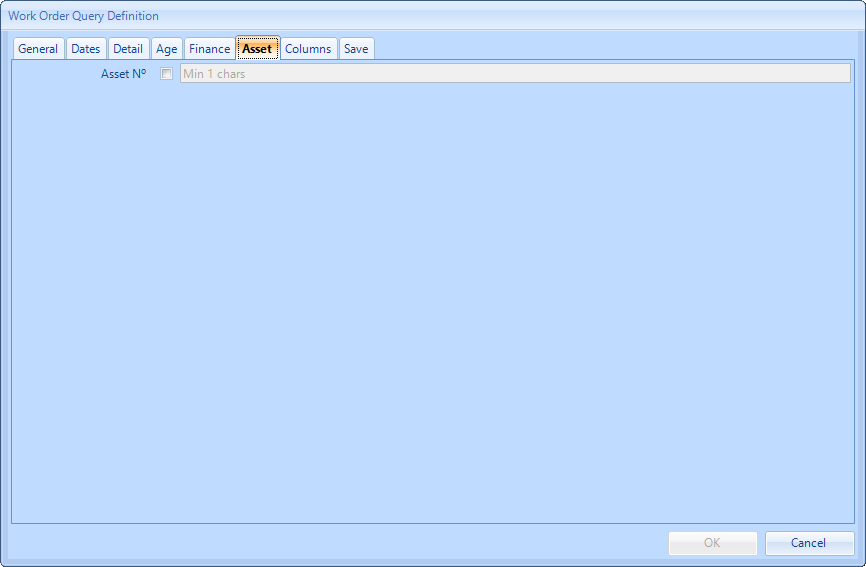
7. The next tab of the Work Order Query Definition screen is the Columns tab. Before the user returns their results, the selection of columns should be performed. There is a default set of columns always ticked, but this tab allows for the selection of further columns if it is required. On this tab, you can also set the Default Sort column and whether it sorts ascending or descending:
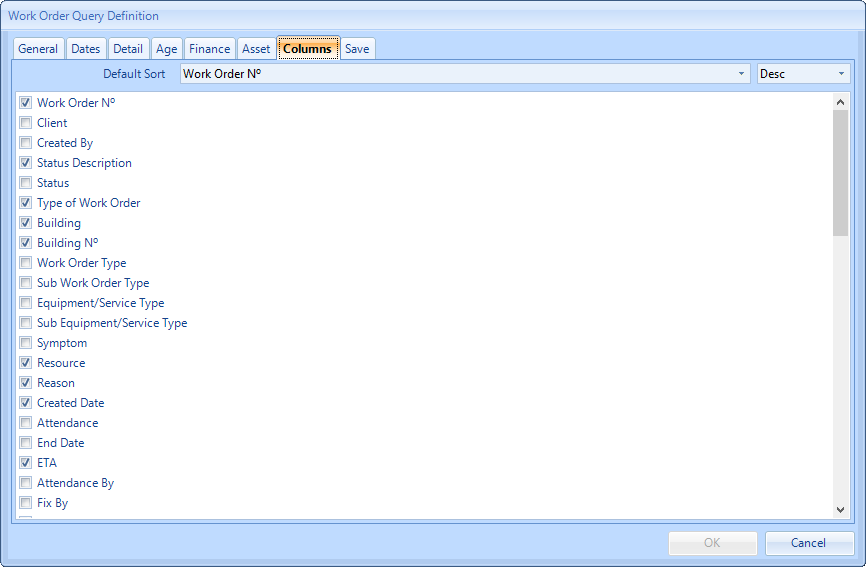
8. The final tab of the Work Order Query Definition screen is the Save tab. Once all details of the search have been entered, go to the Save tab to save the query for later use. There are four types of lists accessible from the Work Order Lists menu:
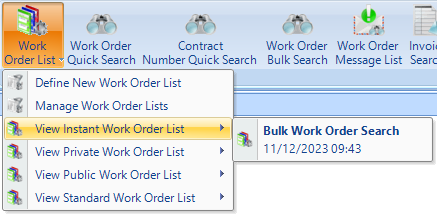
Instant Select the WO list type of "Instant" to display the selection as a one off list. The results will be shown one time only and the criteria will need to be entered again should the User close the results page. This type of list cannot be saved, but the last three "Instant List Searches" are retained, one of which is shown in the screenshot above.
Private Select a WO list type of "Private" to save the list to the User’s own Private List. Add a WO List Name and Description and select the OK button. These are then available each time that User logs on.
Public Select a WO list type of "Public" so save the list to the Public Lists. Add a WO name and description, select the "viewable by" profiles and select the OK button. Any User that has the permission "Can Delete Public Work Order Lists" will be able to see all Public Lists in the system and delete them.
Private Select a WO list type of "Private" to save the list to the User’s own Private List. Add a WO List Name and Description and select the OK button. These are then available each time that User logs on.
Public Select a WO list type of "Public" so save the list to the Public Lists. Add a WO name and description, select the "viewable by" profiles and select the OK button. Any User that has the permission "Can Delete Public Work Order Lists" will be able to see all Public Lists in the system and delete them.
Standard This is not selectable as a type of list to "Save as", but it is possible to edit standard lists to include more/different columns as a default.
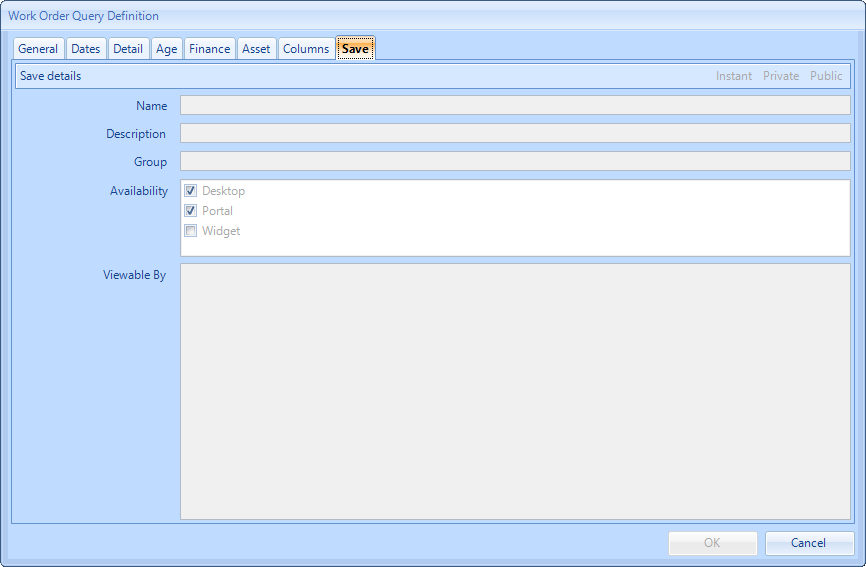
7. Once all the desired criteria has been selected and information has been entered, click the "OK" button to perform the search. If the Save tab was also populated, clicking "OK" will save the list as well as perform the search. Clicking the "Cancel" button to close the Work Order Query Definition.
8. The Work Order list view will then appear with the record(s) that match the criteria specified. The Work Order list will appear with no records if no records match the criteria entered.
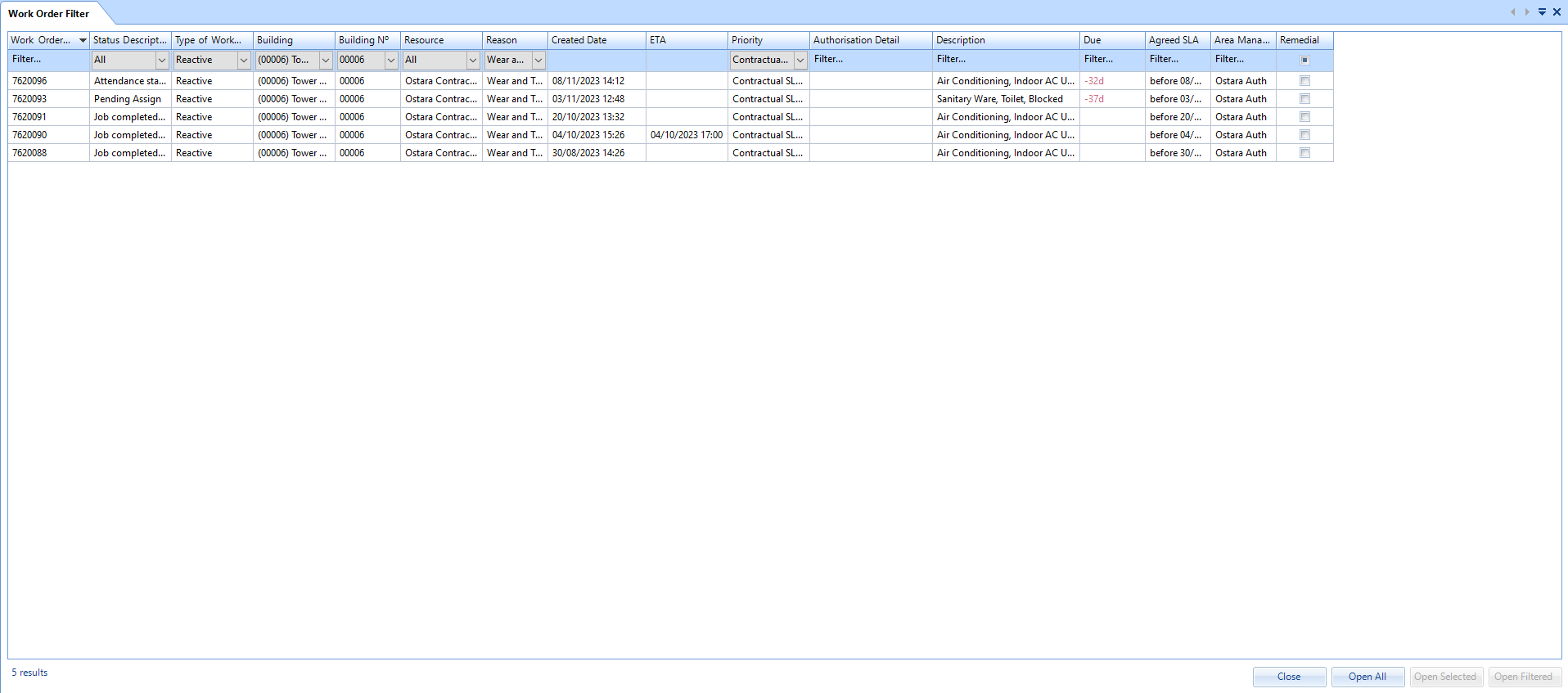
9. The User will now be able to see all of the Work Orders relevant to the criteria defined in the previous screen.
10. To view a specific Work Order, double click on the line, this will take you to the Work Order Detail screen.
11. To view all the Work Orders in this list use the "Open All" button. "Open Selected" will open any Work Orders that have been highlighted. The User can also open all filtered Work Orders by clicking on the "Open Filtered" button.
Note: The Work Order List is limited to return a maximum of 8,000 results. The User will receive an informational message should the results of their search exceed this amount and the criteria will need to be amended to return a smaller number of Work Orders.